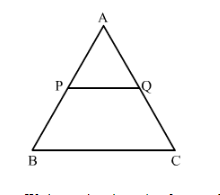ABC is a triangle and PQ is a straight line meeting AB in P and AC in Q. If AP = 1 cm, PB = 3 cm, AQ = 1.5 cm, QC = 4.5 m,
ABC is a triangle and PQ is a straight line meeting AB in P and AC in Q. If AP = 1 cm, PB = 3 cm, AQ = 1.5 cm, QC = 4.5 m, prove that the area of ∆APQ is one-sixteenth of the area of ∆ABC.
Given: In ΔABC, PQ is a line segment intersecting AB at P, and AC at Q. AP = 1cm, PB = 3cm, AQ = 1.5cm and QC = 4.5cm.
To find: $\operatorname{Ar}(\triangle \mathrm{APQ})=\frac{1}{16}(\triangle \mathrm{ABC})$
In ΔABC,
$\frac{\mathrm{AP}}{\mathrm{PB}}=\frac{\mathrm{AQ}}{\mathrm{QC}}$
$\frac{1}{3}=\frac{1.5}{4.5}$
$\frac{1}{3}=\frac{1}{3}$
According to converse of basic proportionality theorem if a line divides any two sides of a triangle in the same ratio, then the line must be parallel to the third side.
Hence, $\mathrm{PQ} \| \mathrm{BC}$
In $\triangle \mathrm{APQ}$ and $\triangle \mathrm{ABC}$,
∠APQ=∠B Corresponding angles
∠PAQ=∠BAC Common
So, ∆APQ~∆ABC (AA Similarity)

We know that the ratio of areas of two similar triangles is equal to the ratio of squares of their corresponding sides.
Hence
$\frac{A r(\Delta \mathrm{APQ})}{A r(\Delta \mathrm{ABC})}=\frac{\mathrm{AP}^{2}}{\mathrm{AB}^{2}}$
$=\frac{\mathrm{AP}^{2}}{(\mathrm{AP}+\mathrm{BP})^{2}}$
$=\frac{1^{2}}{(1+3)^{2}}$ (given)
$\frac{\operatorname{Ar}(\Delta \mathrm{APQ})}{\operatorname{Ar}(\Delta \mathrm{ABC})}=\frac{1}{16}$
$A r(\Delta \mathrm{APQ})=\frac{1}{16} A r(\triangle \mathrm{ABC})$
